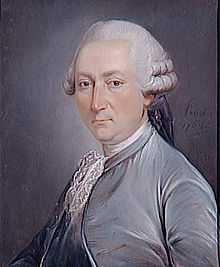Jean-Rodolphe Perronet
| Jean-Rodolphe Perronet | |
|---|---|
 Jean-Rodolphe Perronet | |
| Born |
27 October 1708 Suresnes |
| Died |
27 February 1794 Paris |
| Nationality | French |
| Engineering career | |
| Significant projects | Pont de la Concorde |
| Significant advance | arch bridges |
Jean-Rodolphe Perronet (27 October 1708 – 27 February 1794) was a French architect and structural engineer, known for his many stone arch bridges. His best known work is the Pont de la Concorde (1787).
Life and career
Perronet was born in Suresnes, a suburb of Paris, the son of a Swiss Guardsman. At 17 he entered the architectural practice of Jean Beausire, "first architect" to the city of Paris, as an apprentice. He was put in charge of the design and construction of Paris's grand sewer, embankment works and the maintenance of the banlieue's roads. In 1735, he was named sous-ingénieur (under-engineer) to Alençon and in 1736 entered the Corps des ponts et chaussées. In 1737, he became sous-ingénieur, then engineer to the généralité of Alençon.
In 1747, Perronet was named director of the Bureau des dessinateurs du Roi (Royal office of designers), which had also just put Daniel-Charles Trudaine in charge of producing maps and plans for the kingdom. This first École des ponts et chaussées was based in the hôtel Libéral Bruant in Paris. Perronet was given the task of training bridge and road engineers and of overseeing their work in the généralités in which they worked. The Bureau became the Bureau des élèves des ponts et chaussées, then in 1775 was renamed the École des ponts et chaussées. Its organiser, inspiration and teacher, Perronet was a true spiritual father to his students and used a new teaching method which seems very contemporary to modern eyes. During this time he became friends with the Swiss bridge-builder Charles Labelye.

Gothenburg Museum of Art
He was named premier ingénieur du roi in 1763 and became a member of the associate of the Académie des sciences in 1765. Besides his bridges, between 1747 and 1791, 2500 km of roads were created or repaired under his direction. He also contributed the article Pompe à feu (fire-engine) to the Encyclopédie ou Dictionnaire raisonné des sciences, des arts et des métiers.[1]
In 1772, Perronet was elected a foreign member of the Royal Swedish Academy of Sciences. He died in Paris, aged 85. He was elected a Fellow of the Royal Society in 1788.[2]
The street next to the site of the École des ponts et chaussées (delimiting Paris's VIe and VIIe) is now named after him and a statue of him has been erected on the north east corner of the Île de Puteaux, at the foot of the pont de Neuilly (whose first stone version, built in 1772 and surviving until 1942, was his work).
Works
- 1750-1760 : Bridge at Orléans.
- 1757-1765 : Bridge at Mantes.
- 1758-1764 : Bridge at Trilport.
- 1765-1786 : Bridge at Château-Thierry.
- 1766-1769 : Pont Saint-Edne at Nogent.
- 1768-1774 : Bridge at Neuilly-sur-Seine.
- 1770-1771 : Pont Les Fontaines.
- 1774-1785 : Bridge at Sainte-Maxence sur l’Oise.
- 1775 : Bridge at Biais-Bicheret.
- 1776-1791 : Bridge at Nemours.
- 1784-1787 : Bridge at Brunoy.
- 1786-1787 : Bridge at Rosoy.
- 1786-1791 : Pont Louis XVI, later renamed Pont de la Concorde, Paris.
Sources
- (French) Guy Coriono, 250 ans de l’École des Ponts en cent portraits, Paris, Presses de l’École nationale des Ponts et Chaussées, 1997, p. 37 and following.
- (French) M. Guillot, "Un destin helvétique, Jean-Rodophe Perronet et sa famille suresnoise (1708-1794)" in Les gardes suisses et leurs familles au XVIIe et XVIIIe siècles en région parisienne, p. 108-116.
- (French) Yvon Michel, "Jean-Rodolphe Perronet (1708-1794)" in Monuments Historiques, Paris, April–June 1987, nos 150-151, p. 81-86.
- (French) Claude Vacant, Jean-Rodolphe Perronet (1708-1794). Premier inégénieur du Roi et directeur de l’École des ponts et chaussées, Paris, Presses de l’École Nationale des Ponts et Chaussées, 2006. 24 cm, 344 p., ill.
External links
- (French) Biography (EPC)
- (French) Biography (Structurae)
- (French) Jean-Rodolphe Perronet : article Pompe à feu in the Encyclopédie ou Dictionnaire raisonné des sciences, des arts et des métiers
- Britannica
|